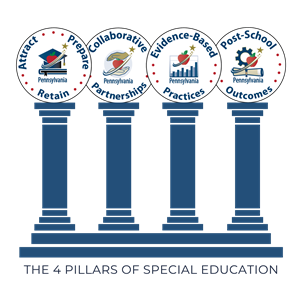
PaTTAN plays a critical role in the
Bureau of Special Education’s systemic alignment* by delivering customized professional development and technical assistance aligned with four key Implementation Pillars—the core strategies for driving improvement: Attract-Prepare-Retain; Collaborative Partnerships; Post-School Outcomes; and Evidence-Based Practices. Through this coordinated approach, Pennsylvania strengthens educator capacity, fosters collaboration, and advances equitable opportunities for all students with disabilities.
The
Outcomes and
Targets for each Pillar are listed below:
Outcome: Increase qualified long-term employees
Targets:
- Develop and expand recruitment and preparation pathways for Teachers of the Visually Impaired (TVI), Deaf and Hard of Hearing (DHH), and educational interpreters
- Increase specialized professional development for general education teachers
- Expand career growth and leadership opportunities
Outcome: Increase parents’ and other agencies’ ability to work together effectively in support of students
Targets:
- Expand family and community engagement in decision-making
- Offer training for families on navigating special education
- Strengthen leadership capacity for building a continuum of services
Outcome: Increase teachers’ use of instructional, engagement, and behavioral management practices that are research-based
Targets:
- Strengthen leadership capacity to guide and sustain evidence-based practices
- Expand coaching and side-by-side support for implementing evidence-based practices (EBPs)
- Develop and implement systemic support plans and/or local supports to train educators on supporting students with low-incidence disabilities in the general education curriculum
Post-School Outcomes
Outcome: Increase the number of students with disabilities entering competitive integrated employment
Targets:
- Extend educator training on career readiness, transition planning, and work-based learning
- Expand collaboration with employers and workforce development programs to provide internships, apprenticeships, and supported employment opportunities
- Increase use of assistive technology and workplace accommodations to support inclusive employment and independent living skills
*The Bureau of Special Education’s systemic alignment creates an integrated framework that connects fiscal management, compliance monitoring, and professional development to provide cohesive support for local education agencies (LEAs). This alignment ensures that resources, accountability systems, and instructional practices work together to promote evidence-based strategies and measurable improvements in student outcomes.